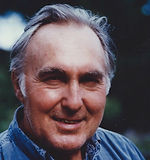History of the Farm
Our Community Farm began with a series of conversations and meetings between Trauger Groh, Lincoln Geiger and Anthony Graham in early 1986. Many others in the local community became actively involved as we moved towards our first season.

Trauger Groh
Lincoln Geiger
Anthony Graham
Our intent was to start a Biodynamically run farm that would be supported by members of the local community. We eventually formed the idea of having a group of families supporting the farm for one year through monthly pledges and these 'farm members' would receive the raw produce of the the farm in return for their support.
We began in the spring of 1986 and continued to farm in Temple and West Wilton NH until 1994. In 1995 we moved the whole farm to the West Wilton site and then in 1998 we moved again to Four Corners Farm on Abbot Hill in Wilton. By that time we were very aware of the need to secure the land we were farming!
Over the course of the next 15 years, with the help of the federal Farm and Ranchland Protection Program, the NH LCHIP program, the Town of Wilton, Living Lands Trust and various other organizations and individuals, we were gradually able to raise the funds to secure all of our vegetable and hay fields and donate them to land trusts. Finally in 2016, with the generous help of the New Hampshire Community Loan Fund, we were able to buy Four Corners Farm so that we now have a stable land base to help the farm move into the future.
Our Aims and Intentions
Below is a document that was originally written by Trauger Groh at the inception of the farm, describing what we called our ‘Aims and Intentions’. This explains some of the ideas that motivated us when the farm began.
TEMPLE WILTON COMMUNITY FARM
AIMS AND INTENTIONS
Our community farm was born out of the desire of a group of farmers and gardeners to unite their efforts and their land into one organism in order to serve the local community with biodynamically grown food. The first meetings took place in February and March of 1986 and out of these meetings came forth some basic concepts, aims and principles:
FARMERS
By accepting responsibility for the agricultural use of the land, all members of our Community Farm become ‘farmers’. Either they enact their right to farm directly, by planning and doing the farm work, or they let those members who have the time and skills to do so, farm in their name. Those members who do the planning and farm work on an ongoing basis and as a main occupation, are the ‘active farmers’ (henceforth referred to as 'the farmers').
LANDHOLDERS
The landholders give the members of the Community Farm the right to use their farmland and buildings. All costs of the property (land taxes, insurance, depreciation, and repairs) are carried by the Community Farm.
AIMS OF THE ACTIVE FARMERS (FARMERS) AND THE SUPPORTING FARMERS (MEMBERS):
1) Spiritual Aims
- To make the annual renewal of life on earth possible in such a way that both the individual and humanity at large are free to pursue their spiritual destinies.
- To make land-use and working of the land a path of self-education: an education in the sense that a better understanding of nature can lead to a better understanding of ourselves.
- To create the farm organism in such a way that it is made available therapeutically to those who suffer from damages created by civilization and from other handicaps that need special care.
2) Legal Aims
- To make access to farmland available for as many people as possible through the use of covenants and easements that protect the land from development, in perpetuity.
- To create forms of cooperation that allow us to separate the financial needs of the farmers, and of the farm, from the economic value of the food.
3) Economic Aims
- To create a farm that is, as far as possible, a self-contained natural organism, such that with the help of its own natural ecology it reproduces itself better and better, becomes more and more diversified, and needs decreasing inputs of substances and energy from the outside. This will also allow human labor to be used as efficiently as possible.
- Individual profit through farming is not an economic aim of the farmers.

The following formula has allowed the farm to operate smoothly since its inception:
All unprocessed farm produce (vegetables and milk) is available to members free of charge if they meet the proposed budget through contributions over the course of one year. This enables us to sever the direct link between the food and the money.
Pledges are based on the ability to pay, rather than on the amount of food to be taken. Having made a contribution, each member household is free to take as much food as is needed, depending on availability.
